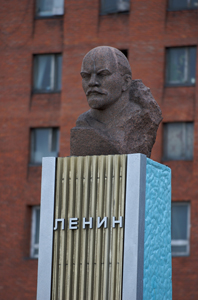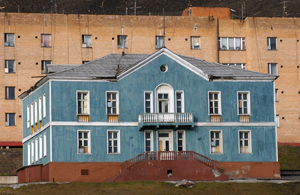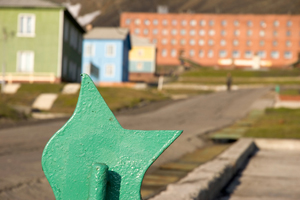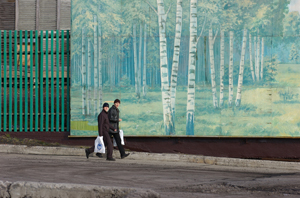Barentsburg
[78° 03.9' N 14° 13.5' E]
By Øystein Overrein (ed.), Jørn Henriksen, Bjørn Fossli Johansen, Kristin Prestvold
The settlement closest to the Norwegian administrative centre in Svalbard is the Russian mining town of Barentsburg. In its beautiful setting in Grønfjorden, the town is in stark contrast to the landscape around it. Barentsburg differs from Longyearbyen in being a community based around its dominant industry – mining. But there is also a small tourism industry respresented by a hotel, a souvenir shop and a museum. For many visitors it is interesting just to walk the streets, look at the architecture and get in touch with the locals. The population in Barentsburg was previously around 1000, today the population is reduced to 400-500.
Take care:
- The museum, the souvenir shop, the chapel and the hotel are the only buildings you can visit without special permission.
- Keep a safe distance from the areas with industrial activity.
- Do not walk outside the settlement without proper polar bear protection.
 Lenin still has a prominent position in town. (Image: Jørn Henriksen) Lenin still has a prominent position in town. (Image: Jørn Henriksen)
 The architecture in Barentsburg is characteristic and very different from Longyearbyen. Here we see two buildings from different epochs. Today, this builiding is renovated and has a mint green color. (Image: Jørn Henriksen) The architecture in Barentsburg is characteristic and very different from Longyearbyen. Here we see two buildings from different epochs. Today, this builiding is renovated and has a mint green color. (Image: Jørn Henriksen)
 The only penguins in the High Arctic are gaping for garbage in Barentsburg. (Image: Jørn Henriksen) The only penguins in the High Arctic are gaping for garbage in Barentsburg. (Image: Jørn Henriksen)
 Several of the buildings in Barentsburg are beautifully decorated. (Image: Jørn Henriksen) Several of the buildings in Barentsburg are beautifully decorated. (Image: Jørn Henriksen)
Barentsburg is located on the east side of Grønfjorden. The rich coal seam was visible on this side of the fjord and in the early 20th century several companies with plans of exploiting coal annexed this area.
In 1916 the company De Russiske Kulfelter Green Harbour opened a mine in Gladdalen. During the first years of activity the installation was gradually expanded to become quite large in scale for its time.
In 1920 the installation was sold to the newly established Dutch company Nederlandsche Spitsbergen Compagnie (NESPICO) and was renamed Barentsburg after the Dutch seafarer, Barentsz, who first discovered Svalbard. The Dutch invested a lot here during the following years. The living quarters for the company’s workers were very good, surpassing the standard of the other mining communities in Svalbard in the 1920s. Due to a shortage of funds the activity was discontinued in 1926.
During the following years NESPICO maintained a crew of watchmen in the mining town. Attempts to raise fresh capital were unsuccessful and in 1932 all installations and claims were sold to the Russian company Trust Arktikugol. The Russians developed the mining town and in 1935 the restructuring of the mines and the infrastructure was completed.
Barentsburg was shelled and burnt and virtually demolished when the German battle ship Tirpitz attacked in 1943. After the war the town was rebuilt. The large coal storage, situated centrally in Barentsburg, is one of the few remains from the NESPICO period. This is the single largest protected cultural remain in Svalbard. This installation and the large mess building are the only pre-war constructions.
After the war old and new mines were opened. In the beginning of the 1950s the rebuilding of Barentsburg was finished and production had nearly regained its prewar level. Production increased in the 1960s and 1970s.
During the 1960s, 1970s and 1980s work in Barentsburg was sought after. It was well paid and workers were encouraged to participate in the activities organized at the settlement’s culture centre and sports hall. The food supply from the mainland was good and the food was free. There was also a limited production of vegetables, milk, meat and eggs at the settlement.
In recent years Barentsburg has suffered several major accidents. 141 people on the way to Barentsburg died in a plane crash 29 August 1996 during the approach to Longyearbyen. It was the biggest air disaster on Norwegian soil. In 1997 23 miners died in a mine fire in Barentsburg. Since 1989, a total of 47 men have died in Barentsburg. In 2013 two miners were killed in two separate accidents.
Up until 1970 most of the buildings in Barentsburg were simple cog-jointed timber houses of two or three stories. In the 1970s and 1980s several brick buildings were built. Today Barentsburg’s streets and blocks of flats and are characteristically Russian. The Russian settlement is of significant architectural interest. In recent years the Trust Artikugol has undertaken an extensive renovation and restoration of several buildings
Landing sitesBarentsburg can accommodate most vessels. Recommended trailsFrom the Harbour Office you can mount the approximately 250 steps up to the Mess building’s entrance. The top of the stairs is a good starting point to explore the town, which is centred around the entrance to the coal mine. To the right of the Mess are the town square and the cultural and sports building. This building also houses a souvenir shop, offering lots of locally produced crafts. If you follow the concrete street to the right, above the cultural and sports building, you will see the hotel at the end of the street. On this street you will also find the Pomor Museum, which hosts a good geological collection and an archaeological exhibition about Pomor history in Svalbard.
|